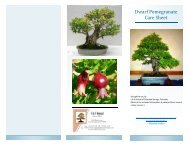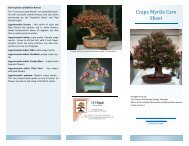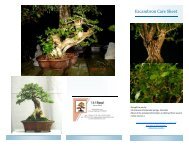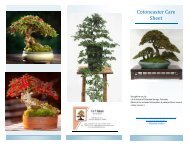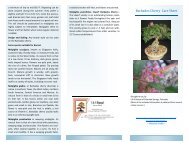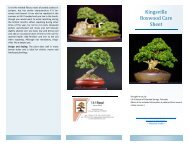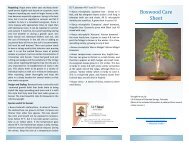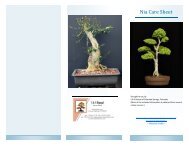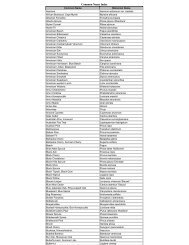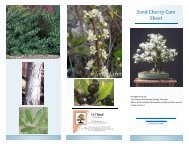Brush Cherry Care Sheet
Brush Cherry Care Sheet
Brush Cherry Care Sheet
Create successful ePaper yourself
Turn your PDF publications into a flip-book with our unique Google optimized e-Paper software.
After repotting, water thoroughly and keep the plant<br />
in a shady location for several weeks so that new<br />
roots may grow.<br />
Diseases: No diseases are of major concern. May<br />
drop leaves if watering is inconsistent. Not salt<br />
tolerant.<br />
<strong>Brush</strong> <strong>Cherry</strong> <strong>Care</strong><br />
<strong>Sheet</strong><br />
Winter <strong>Care</strong>: <strong>Brush</strong> Cherries should be kept indoors<br />
during the winter months. Display them in a sunny<br />
spot that does not go below 55°F.<br />
Some species suitable for bonsai:<br />
Eugenia brasiliensis: Brazil cherry - likes slightly higher<br />
winter temperatures (64°-68°F) than other Eugenia<br />
species. Needs good light for its red, edible fruit to<br />
develop.<br />
Eugenia cauliflora: Jaboticaba - Native from southern<br />
Brazil to southern California, southern Florida and<br />
Hawaii, the jaboticaba has creamy tan bark with<br />
pinkish and grayish highlights that peels in long strips<br />
like crepe myrtle. It will bear purple edible ovoid fruit<br />
when the plant is about 15 years old. Expect the<br />
jaboticaba to lose about half its leaves in early spring,<br />
before the new growth sets in.<br />
Eugenia myrtifolia (also called Syzygium paniculatum):<br />
Australian brush cherry - Grows to 20 feet. Red, eggshaped<br />
edible fruits. If it receives enough light, the<br />
leaves will develop red highlights. Prefers winter<br />
temperatures of 59°-64°F.<br />
Eugenia myrtifolia var. Globulus (also called Syzygium<br />
paniculatum): 'Teenie Genie' cherry - a popular,<br />
widely available choice, much loved for bonsai due to<br />
its extremely small leaves.<br />
Eugenia uniflora: Surinam cherry, Brazil cherry,<br />
pitanga - hardy to zone 10, this tropical "cherry" has<br />
round red and yellow fruits, which can be used in<br />
preserves and sherberts.<br />
Brought to you by<br />
S & S Bonsai of Colorado Springs, Colorado<br />
(Most of the included information is obtained from several<br />
online sources.)<br />
“Live as if you were to die tomorrow. Learn as if<br />
you were to live forever.”<br />
—Mahatma Gandhi—
The <strong>Brush</strong> <strong>Cherry</strong><br />
(Eugenia sp. Or Syzygium)<br />
Family: Myrtaceae<br />
Genus: Eugenia<br />
Species paniculata<br />
General Information: Eugenia is a large group of<br />
plants, some native and some non-native, including<br />
evergreen trees and shrubs, some of which have been<br />
reclassified to the genus Syzygium. The evergreen<br />
leaves are firm and glossy, and the flowers white. It is<br />
the dried buds of Eugenia aromatica (Syzygium<br />
aromaticum) which become the fragrant "herb"<br />
cloves. The flowers are followed by the production of<br />
berries, some types of which are edible. All these<br />
traits - the attractive foliage, flowers, and berries -<br />
help make Eugenia a popular landscape choice in<br />
warm climate areas, such as California, Florida, and<br />
Hawaii. Eugenia confusa (Ironwood, Red Stopper) is<br />
native to Florida and grows to about 35 feet and is<br />
well suited for street tree and parking lot planting.<br />
Eugenia foetida (Spanish Stopper) is also native and<br />
grows to about 15 feet tall.<br />
A sub-tropical evergreen, with dark green ovate<br />
leaves formed in pairs. In spring, may bear small<br />
white flowers followed by red, edible fruit. With the<br />
exception of jaboticaba, Eugenia species have red,<br />
flaking bark. Surinam cherry is used extensively as a<br />
hedge plant in the Southern US.<br />
<strong>Brush</strong> Cherries are ideally suited for bonsai. There are<br />
many different varieties that are natural dwarfs.<br />
These varieties have very small leaves and slow<br />
growth habits. Types of <strong>Brush</strong> Cherries include,<br />
Australian Dwarf <strong>Brush</strong> <strong>Cherry</strong>, and 'Teenie Genie'<br />
<strong>Brush</strong> <strong>Cherry</strong>, to name a few. In the proper conditions<br />
some <strong>Brush</strong> Cherries form a small cream colored ball<br />
that later opens into a beautiful starburst bloom.<br />
Barbados and Weeping Barbados Cherries form<br />
strands of bright pink flowers. <strong>Brush</strong> Cherries should<br />
be kept indoors all year round. With a few simple<br />
guidelines your <strong>Brush</strong> <strong>Cherry</strong> bonsai can be grown<br />
without difficulty.<br />
CARE<br />
General <strong>Care</strong> :<br />
Temperature: Never below 40°F. Generally hardy in<br />
zones 10B and 11, otherwise can successfully be<br />
grown indoors. In summer, Eugenia likes the heat,<br />
while it prefers winter temperatures between 46-<br />
68F. Eugenia does not like draughts or a lot of<br />
variation in temperature.<br />
Lighting: Full sun to part shade. Appreciates a bright<br />
position, about 1500 Lux, but can tolerate low light. If<br />
placed outdoors in summer, can usually tolerate full<br />
sun, although partial shade is recommended in the<br />
hottest areas. <strong>Brush</strong> <strong>Cherry</strong> bonsai grow well in either<br />
direct or indirect sunlight. We prefer to grow <strong>Brush</strong><br />
<strong>Cherry</strong> in shady areas, out of the hot afternoon sun.<br />
Sometimes the direct afternoon sun can burn<br />
delicate leaves, especially when shining through a<br />
household window. Direct morning sunlight is great<br />
for almost all bonsai because of its low intensity.<br />
Watering: <strong>Brush</strong> Cherries, as with most bonsai, like to<br />
dry out between waterings. Feel the soil every day. If<br />
there is a rock in the planting lift it up and feel under<br />
it, otherwise, just stick your finger about a half of an<br />
inch to an inch into the soil. If the soil feels dry, water<br />
your bonsai. Never let your bonsai go totally dry for<br />
extended periods!!! The best way to water your<br />
bonsai is to soak it in a sink or container of water up<br />
to the trunk for about 5 to 10 minutes. Then allow it<br />
to drain. If top watering your bonsai, water, wait a<br />
few minutes, and water again. Repeat this several<br />
times to insure that your bonsai has received a<br />
thorough watering. Eventually you will be able to<br />
determine a watering schedule that meets your<br />
climate conditions. Water generously in summer, less<br />
in winter. Surinam cherry does not like variations in<br />
watering, preferring a consistently slight moisture to<br />
being soaked and allowed to dry out. Lesniewicz<br />
recommends that Australian <strong>Brush</strong> cherry dry a little<br />
between waterings, but some posts testify that it will<br />
drop leaves if the soil dries.<br />
Humidity: Humidity around your <strong>Brush</strong> <strong>Cherry</strong> bonsai<br />
may be maintained by the use of a humidity tray or<br />
plate filled with stones and water. Your bonsai can be<br />
placed on top of the stones in the tray. The tray or<br />
plate will also offer protection from the draining<br />
water of your freshly watered bonsai. Misting once a<br />
day will also help…but remember, misting is not a<br />
replacement for watering. Use distilled/rain water if<br />
your water is hard, as Eugenia does not tolerate salt.<br />
Fertilizing: Every 2 weeks during heavy growth, and<br />
every 4-5 in winter. We recommend using an organic<br />
liquid fertilizer such as a fish emulsion or an organic<br />
seaweed fertilizer. Chemical fertilizers may be used<br />
but should be diluted to approximately one half<br />
strength so that valuable roots are not damaged.<br />
Organic pellets may also be used along with regular<br />
fertilizers. Eugenia likes a slightly acid soil, so the<br />
occasional use of Miracid is recommended.<br />
Flower/Fruit: The brush cherry develops white to<br />
cream colored flowers usually in the spring and<br />
summer. The fruits develop several months later and<br />
vary in color from yellow to a dark red or black. Most<br />
of the varieties have a round fruit but some are<br />
ribbed much like a pumpkin. The fruit of most<br />
varieties is edible , although very acidic.<br />
Pruning / Training: Can be pruned back hard, as it is a<br />
vigorous grower. Shorten new shoots with 6-8 pairs of<br />
leaves to 1-2 pairs. Can be wired while in active<br />
growth, but better shaping results are achieved with<br />
pruning. Protect the branches, as they scar easily. Leaf<br />
pruning can be done in summer on strong plants, but<br />
is not generally advised, as better leaf reduction<br />
results from timely pruning, and this plant has<br />
relatively small leaves in the first place. It is suitable<br />
for all styles, and for all but the largest sizes.<br />
Insects / Pests: Scale, mealy bug, Caribbean fruit fly,<br />
aphids, red spider. Psyllids limit the tree's usefulness<br />
in parts of California.<br />
Propagation: By cuttings in summer, seeds in fall, airlayering.<br />
Repotting: Every two years in early to mid-spring.<br />
Bottom heat helps to encourage root growth.<br />
Minimum night temperatures low to mid 60’s°(F). Use<br />
basic well draining bonsai soil, or an acid mix like<br />
azalea soil. Some species of Eugenia do not tolerate<br />
severe root pruning, do your homework and research<br />
this further, so use caution not to prune roots back<br />
too far when repotting.




